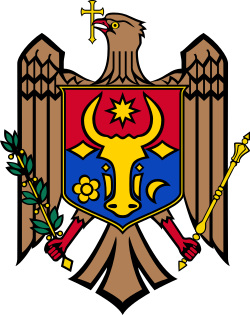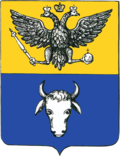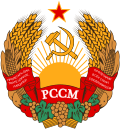| Coat of arms of Moldova | |
|---|---|
 | |
| Armiger | Republic of Moldova |
| Adopted | 13 July 1990 |
| Shield | Per fess gules and azure, an aurochs head cabossed overall, accompanied by two lozenges to its sides, a mullet of eight points between the horns, a heraldic rose to dexter and a crescent decrescent to sinister, all or. |
| Supporters | Behind the shield: an eagle (heraldic, wings inverted) proper (golden brown), beaked and membered gules, holding in his beak a cross or, in his dexter talon an olive branch vert and in his sinister a scepter or. |
The coat of arms of Moldova is the national emblem of the Republic of Moldova. It was designed by Moldovan artist Gheorghe Vrabie. [1]
Contents
The escutcheon's aurochs head accompanied by a rose, crescent and pointed star is derived from the coat of arms of the Principality of Moldavia. The heraldic supporter of an eagle with a cross in the beak is derived from the interwar coat of arms of the Kingdom of Romania. Most of Moldova's territory was part of Romania between World War I and World War II.










